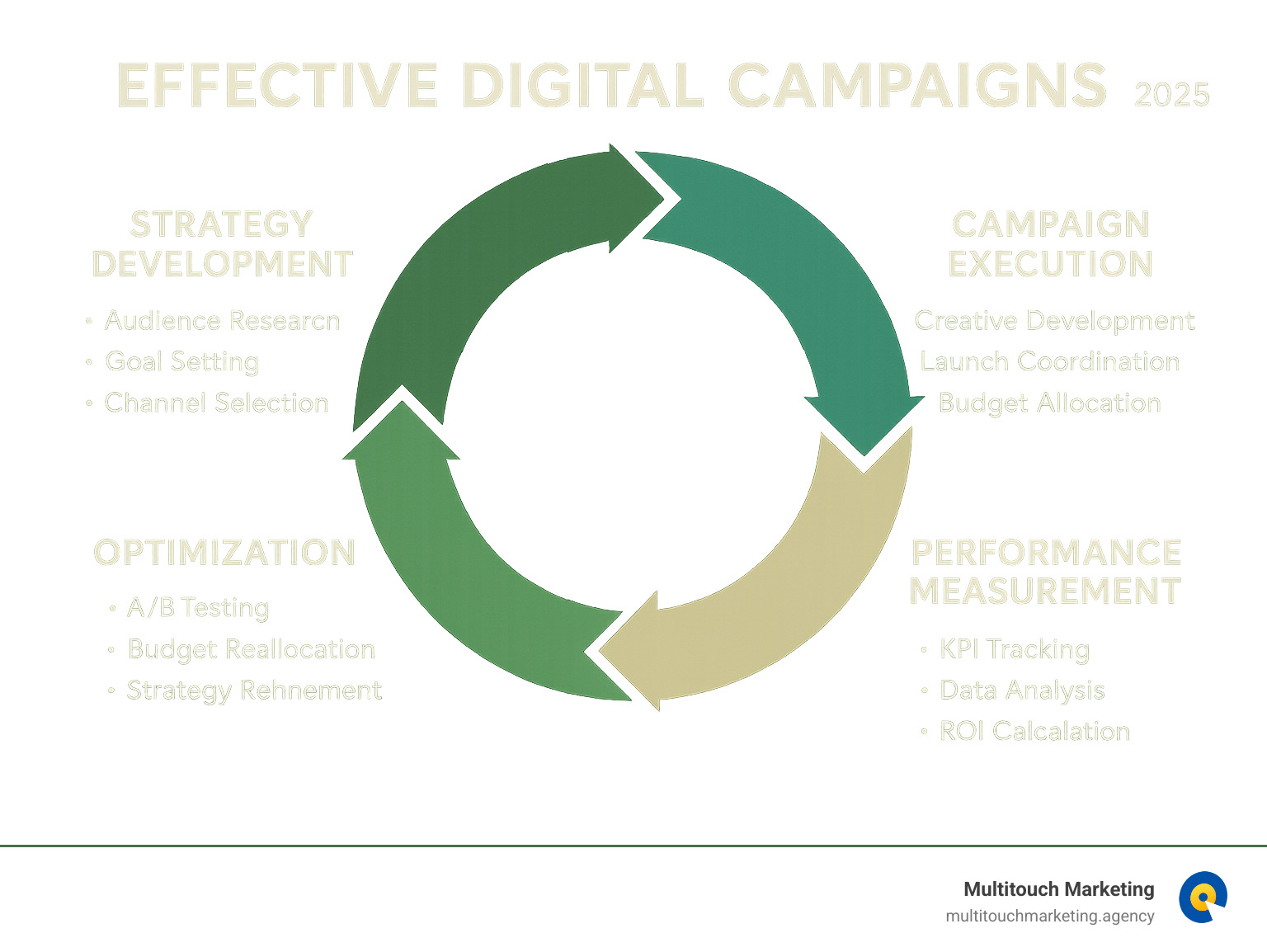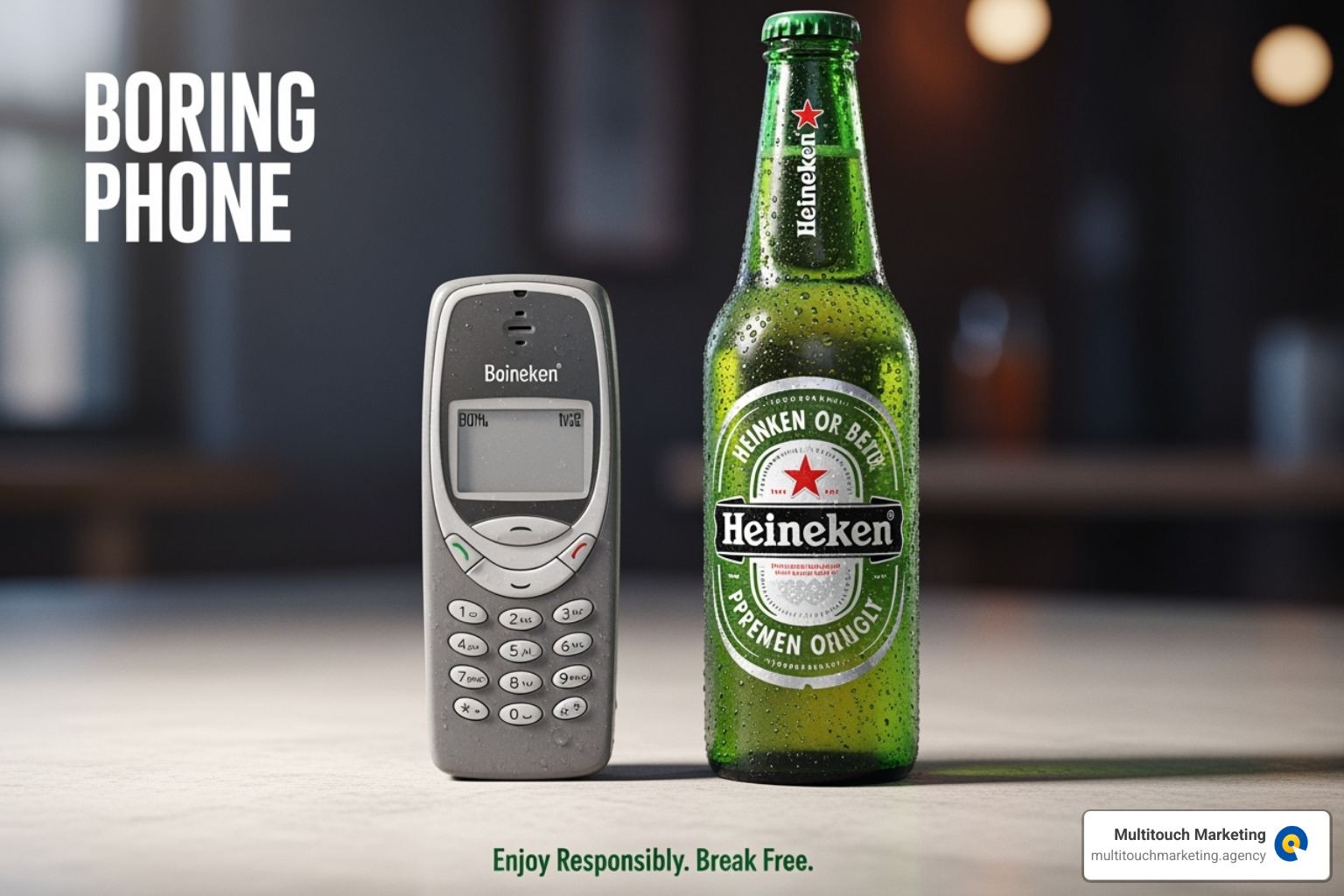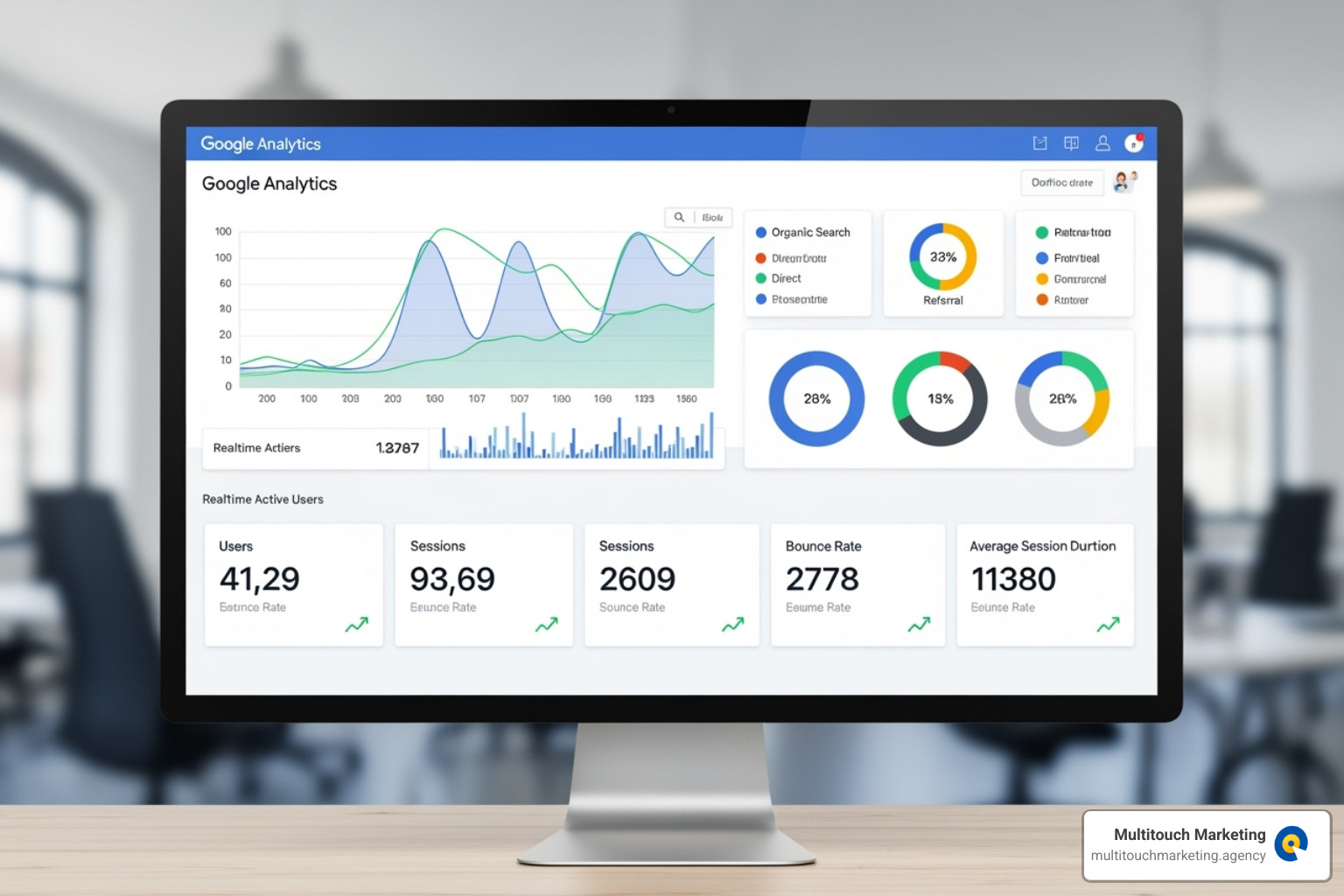Why Effective Digital Campaigns Are the Key to Business Growth
Effective digital campaigns are strategic, data-driven marketing initiatives that combine multiple channels to reach and engage your target audience, ultimately driving conversions and business growth. The most successful campaigns share these core elements:
Essential Components:
- Clear, measurable goals tied to business outcomes
- Audience segmentation based on demographics and behavior
- Multi-channel approach integrating PPC, SEO, social media, and email
- Compelling messaging that resonates with your target market
- Continuous optimization based on performance data
The difference between campaigns that succeed and those that fail often comes down to strategy and execution. As one marketing expert noted, “A conventional definition of a digital marketing campaign as a strategic plan to promote a business online is rapidly becoming insufficient.” Today’s most powerful campaigns are integrated, multi-faceted cultural initiatives that embed brands within consumer conversations.
Consider CeraVe’s anti-advertising campaign, which generated over 32 billion earned impressions – far exceeding their target of 1 billion. Or Dove’s #Faceof10 campaign, which achieved 99% positive sentiment across online conversations. These weren’t just ads – they were strategic initiatives that combined paid, owned, and earned media for maximum impact.
The stakes are high. Businesses that get digital campaigns right can see dramatic results, while those that don’t risk wasting significant ad spend with little to show for it. The key is understanding that effective campaigns require both strategic thinking and tactical precision.
I’m Milton Brown, a strategic digital marketer who has managed Effective digital campaigns with budgets from $20,000 to $5 million across various sectors since 2008. My data-driven approach uses advanced tracking and AI innovations to ensure campaigns deliver measurable business outcomes.
The Blueprint: Core Components of an Effective Digital Campaign
Building effective digital campaigns requires a solid foundation. After years of managing campaigns with budgets from thousands to millions, I’ve learned success comes down to five core components: strategy, planning, audience understanding, clear goals, and smart channel selection. Get these right, and everything else falls into place. Miss one, and even the flashiest creative won’t save you.
Strategy vs. Campaign: Setting the Foundation
Here’s something that trips up a lot of businesses: thinking strategy and campaigns are the same thing. They’re not, and understanding the difference is crucial for success.
Your marketing strategy is your North Star – the long-term roadmap that defines where you want your business to go. It answers the big questions: Who are you as a brand? What markets will you serve? How will you position yourself against the competition? This is your 30,000-foot view that guides everything you do.
A marketing campaign, on the other hand, is how you get there. It’s a focused, time-bound initiative with specific goals, messages, and tactics. If your strategy says “become the go-to source for sustainable home products,” your campaign might focus on launching your new eco-friendly cleaning line to busy parents who care about their family’s health.
The magic happens when these two work together. Your strategy provides the why and what, while campaigns deliver the how and when. Without strategy, campaigns become scattered efforts that waste money. Without campaigns, even brilliant strategies stay stuck on paper.
This relationship is so important that understanding how marketing strategies and campaigns differ can make or break your marketing efforts.
Defining Your Audience and Setting Clear Goals
Want to know the fastest way to waste your marketing budget? Try to talk to everyone. When you’re speaking to everyone, you’re really speaking to no one.
Audience understanding goes way beyond knowing that your customers are “women aged 25-45.” We need to dig deeper into their world. What keeps them up at night? What makes them excited? Where do they hang out online? What problems are they desperately trying to solve?
Building detailed buyer personas means understanding both demographics and psychographics. Knowing age and income matters, but understanding their values, fears, and aspirations is what creates campaigns that truly connect. Tools like our Social Media Audience Insights guide can help you uncover these deeper layers of understanding.
Once you know your audience inside and out, it’s time to set goals that actually mean something. This is where SMART goals and OKRs become your best friends.
SMART goals keep you honest. Instead of saying “get more leads,” you’d say “increase qualified leads by 30% in the next quarter.” It’s specific, measurable, and gives you something concrete to work toward.
OKRs (Objectives and Key Results) connect your big-picture dreams to measurable outcomes. Your objective might be “Become the most trusted brand in our industry,” with key results like “Achieve 90% customer satisfaction scores” or “Generate 500 positive reviews.” These examples of marketing OKRs show how objectives capture your intentions while key results provide the measurable milestones.
Clear goals aren’t just nice to have – they’re essential for proving your campaigns actually work.
Choosing Your Channels: An Integrated Approach
Now comes the fun part: deciding where to show up. The most effective digital campaigns don’t rely on just one channel – they create an integrated experience that meets customers wherever they are.
PPC advertising is our specialty at Multitouch Marketing, and for good reason. When someone searches for exactly what you offer, PPC puts you right there at the perfect moment. It’s like having a salesperson who only talks to people already interested in buying. Learn more about why PPC advertising is beneficial in business.
SEO plays the long game beautifully. While PPC gives you instant visibility, SEO builds lasting organic presence. When your content consistently shows up in search results, you’re not just getting traffic – you’re building trust and authority. Find how SEO pushes business growth over time.
Social media marketing is where relationships happen. Whether it’s Instagram stories, LinkedIn articles, or TikTok videos, social platforms let you show your brand’s personality and build genuine connections. It’s not just about posting – it’s about creating communities around your brand. That’s why social media marketing is necessary for modern businesses.
Content marketing positions you as the helpful expert. Blog posts, videos, guides, and resources don’t just attract visitors – they nurture relationships and guide people through their buying journey. When done right, content marketing makes selling feel natural, not pushy.
Email marketing remains one of the highest-ROI channels available. It’s your direct line to customers and prospects, perfect for nurturing relationships, sharing valuable content, and driving repeat business.
The real magic happens when these channels work together in an omnichannel approach. Someone might find you through social media, research you via organic search, sign up for your email list, and finally convert through a PPC ad. Each touchpoint reinforces your message and moves them closer to becoming a customer.
This integrated thinking is at the heart of Data-Driven Marketing Strategies – every channel supports the others, creating a seamless experience that’s greater than the sum of its parts.
From Theory to Action: Case Studies of Impactful Campaigns
Sometimes, the best way to understand what makes effective digital campaigns is to see how real brands have turned smart strategy into amazing results. These case studies show us exactly how the right mix of creativity, timing, and audience understanding can create campaigns that don’t just get noticed – they get talked about for months.
CeraVe: The Power of Earned Media and Influencer Buzz
What happens when a skincare brand decides to have some fun with conspiracy theories? CeraVe found out with their brilliant “anti-advertising” campaign that had everyone asking: “Wait, is Michael Cera secretly behind this skincare brand?”
The campaign played with the obvious connection between the actor’s name and the brand, creating a months-long mystery that had social media buzzing. They dropped hints, created fake backstories, and let influencers run wild with theories. The whole thing culminated in a Super Bowl commercial that revealed the elaborate joke – and had viewers laughing instead of reaching for their remotes.
The results were nothing short of spectacular. CeraVe generated over 32 billion earned impressions – that’s 32 times their original goal of 1 billion. During the Super Bowl, they captured the #1 share of voice among all brands, with 2.4 times more engagement than other health and beauty companies combined.
Here’s what made this campaign so effective: instead of just buying attention, CeraVe earned it. They understood that people love being in on a joke, and they created something genuinely entertaining that people wanted to share. By being playful and a little absurd, they turned their brand into a conversation starter rather than just another skincare ad.
Dove’s #Faceof10: Purpose-Driven Marketing in Action
Dove has always been known for campaigns that make you think, and their #Faceof10 initiative was no different. When they noticed young children using anti-aging products (the “Sephora Kids” trend), they saw an opportunity to start an important conversation about self-esteem and age-appropriate skincare.
Instead of just pointing out the problem, Dove created a campaign that offered real solutions. They partnered with influencers who genuinely cared about the issue and developed educational resources for parents who were struggling with these conversations at home.
The campaign struck a chord in a big way. 99% of online conversations about the campaign were positive – a remarkable feat in today’s polarized social media landscape. Online searches for related terms jumped by 209%, and their main video content earned over 1.5 million organic views without any paid promotion.
What made this work so well was Dove’s authentic commitment to the cause. They didn’t just use a social issue to sell soap – they provided genuine value through their #TheFaceOf10 campaign resources and educational materials. When brands take a meaningful stand and back it up with real solutions, audiences respond with loyalty and advocacy.
UNIQLO’s “Uncover”: A Masterclass in Omnichannel Engagement
Sometimes the most effective digital campaigns are the ones that blur the line between digital and physical experiences. UNIQLO proved this with their “Uncover” campaign for HEATTECH clothing in Australia, creating an interactive experience that worked both online and on the street.
They set up digital billboards showing videos of people dramatically “uncovering” themselves by removing layers of clothing. But here’s the clever part – passersby could use their smartphones to interact with these billboards and enter a giveaway for HEATTECH items. The experience was shareable, engaging, and directly tied to the product’s core benefit.
The numbers tell the story of this omnichannel experience: 1.3 million video views, 25,000 new newsletter subscribers, and most importantly, 35,000 new customers. That’s not just brand awareness – that’s measurable business growth.
UNIQLO understood that modern consumers move seamlessly between digital and physical spaces, so their campaigns should too. By creating an experience that was fun to participate in and easy to share, they turned a simple product launch into a memorable brand moment that drove real results.
These campaigns show us that the best digital marketing isn’t just about the channels you choose – it’s about understanding your audience so well that you can create experiences they actually want to engage with.
Measuring What Matters: KPIs and Analytics for Campaign Success
You’ve launched your campaign, the ads are running, and the content is live. Now comes the million-dollar question: is it actually working? At Multitouch Marketing, we’ve learned that truly effective digital campaigns aren’t just about creative brilliance or perfect targeting – they’re about knowing exactly what’s happening every step of the way.
Think of campaign measurement like having a GPS for your marketing journey. Without it, you might eventually reach your destination, but you’ll probably take a few wrong turns, waste gas, and arrive much later than planned. With proper measurement, you can course-correct in real-time and optimize your route for maximum efficiency.
Identifying Your Most Important Digital Marketing KPIs
Metrics are plentiful, but insights are what matter. Google Analytics alone offers hundreds of data points. The secret is focusing on Key Performance Indicators (KPIs) that tie back to your business goals, rather than drowning in data.
Return on Investment (ROI) sits at the top of our priority list because it answers the fundamental question every business owner asks: “Am I making money?” If you spend $2,500 on a paid search campaign and it brings in $10,000 in sales, that’s a 300% ROI – and a very happy business owner.
Return on Ad Spend (ROAS) gets more specific about your advertising dollars. When a campaign spends $100 on ads and generates $500 in revenue, you’re looking at a 5:1 ROAS. For context, the median Google Ads ROAS across all industries is about 3.31x, with eCommerce typically seeing around 3x.
Conversion Rate tells us how well your campaign convinces people to take action. A campaign that brings 1,000 visitors to your site and generates 100 leads has a solid 10% conversion rate. This metric is particularly valuable because it helps identify whether your traffic quality matches your targeting strategy.
Cost Per Lead (CPL) and Cost Per Acquisition (CPA) are crucial for budget planning. These metrics tell you exactly how much you’re investing to generate each lead or customer, helping you make informed decisions about scaling your campaigns.
Customer Lifetime Value (CLV) takes the long view, calculating the total revenue you can expect from a single customer throughout your relationship. This metric transforms how you think about acquisition costs – suddenly, spending $200 to acquire a customer worth $2,000 over time makes perfect sense.
We also track Click-Through Rate (CTR) for ads (typically 2-5% is considered good for PPC), bounce rate for website performance (25-40% is excellent), and email open rates (averaging around 21% according to recent data). For businesses that rely on phone calls, call conversions are absolutely critical – and often overlooked.
The key is selecting KPIs that align with your specific goals. A brand awareness campaign will focus heavily on reach and impressions, while a lead generation campaign prioritizes conversion rates and cost per lead. For comprehensive guidance on measurement, resources like How to Measure Marketing Success provide valuable frameworks.
If you’re curious about how your current efforts measure up, our PPC Audit Services can provide detailed insights into your campaign performance.
Leveraging Data to Optimize Your Effective Digital Campaigns
Data without action is just expensive entertainment. The real magic happens when you use insights to continuously improve your campaigns. This is where measurement transforms from reporting to optimization.
Google Analytics serves as our command center for understanding user behavior. This free tool reveals not just how many people visit your site, but how they steer through it, where they came from, and what convinced them to convert (or why they left). The insights are invaluable for optimizing both your campaigns and your website experience.
For precise tracking, we rely heavily on the Google Campaign URL Builder. This simple tool adds tracking parameters to your URLs, allowing you to see exactly which specific ads, emails, or social posts drive traffic and conversions. It’s like having a detailed receipt for every visitor that arrives at your site.
A/B testing is where optimization gets exciting. We create multiple versions of ads, landing pages, or emails and let real user behavior determine the winner. Dell famously saw a 300% increase in conversions through systematic A/B testing. We continuously test everything from headlines and ad copy to calls-to-action and visuals.
The beauty of digital marketing is that optimization never stops. We monitor campaign performance daily, adjusting bids, refining keyword lists, and reallocating budget to top-performing elements. This continuous improvement approach is central to our PPC Campaign Optimization methodology.
Calculating ROI and Proving Campaign Value
Every conversation about marketing budget eventually comes down to one question: “What’s my return on investment?” Calculating ROI accurately – and communicating it clearly – is essential for justifying current spend and securing future budgets.
The basic ROI formula looks simple: (Revenue – Cost) / Cost. But digital marketing ROI gets more nuanced when you consider lead attribution, sales cycles, and lifetime customer value.
For businesses with longer sales cycles, we factor Customer Lifetime Value into our ROI calculations. Consider a legal firm with a 12% close rate and an average client lifetime value of $6,000. If their Cost Per Lead is $132, their ROI is approximately 4.45x (or 345% net return). These calculations help illustrate the true long-term impact of marketing investments.
Lead attribution adds another layer of complexity. In today’s multi-touch customer journey, a conversion might involve several touchpoints – a Google search, a Facebook ad, an email, and a phone call. Understanding which channels contribute to conversions helps us allocate budget more effectively.
We present these insights through comprehensive marketing dashboards that centralize all key metrics in real-time. These dashboards make campaign performance transparent and accessible to stakeholders at every level. For inspiration on building effective dashboards, this guide on building a KPI dashboard offers excellent templates and examples.
The goal isn’t just to measure success – it’s to create a feedback loop that continuously improves performance. This scientific approach to marketing measurement and optimization is what allows us to increase your ROI through scientific SEM.
The best campaigns aren’t just creative or strategic – they’re measurable, optimizable, and accountable. When you can prove value with data, marketing transforms from a cost center to a growth engine.
Future-Proofing Your Strategy: Adapting to Evolving Trends
The digital marketing world never stands still. Consumer behaviors shift, new technologies emerge, and privacy regulations evolve quickly. Brands that win build flexibility into their plans from day one. Future-proofing effective digital campaigns is less about prediction and more about staying adaptive.
By staying informed, testing new tools thoughtfully, and keeping a test-and-learn mindset, you turn industry change into advantage.
Embracing AI and Automation in Your Effective Digital Campaigns
AI already shapes how we create, target, and optimize campaigns. The question is how quickly you can integrate it intelligently.
- Personalization at scale: Deliver relevant content to each user based on behavior and preferences.
- Content creation assistance: Use AI to draft ad copy, brainstorm social posts, and surface topics, while humans lead strategy and creative direction.
- AI-driven optimization: Smart Bidding and Performance Max can improve performance across channels when guided by strong creative and clear conversion signals.
AI Overviews in search may reduce available clicks and push journeys into AI modules, so structure and placement matter even more. For deeper guidance, use our resources on AI in Marketing Strategy and AI Tools for PPC. Many marketers are already experimenting with a certain AI bot to streamline workflows.
Navigating Privacy Changes and Building Trust
As third-party cookies phase out, privacy becomes a growth opportunity.
- Prioritize first-party data from signups, accounts, surveys, and purchases. It’s more reliable, compliant, and valuable.
- Implement Consent Mode v2 and server-side tagging to preserve measurement while respecting user choices.
- Track updates from Google’s Privacy Sandbox for privacy-preserving measurement.
Most importantly, lead with transparency. Clear opt-in/out options and consistent value exchange build trust and loyalty. When people willingly share data, truly effective digital campaigns become possible.
Conclusion: Turning Insights into Action
Creating effective digital campaigns is ongoing work: align to strategy, know your audience, set meaningful goals, and integrate channels. Case studies like CeraVe and Dove show how smart strategy plus cultural relevance drives results.
Measurement turns guesswork into proof. With KPIs like ROI, conversion rate, and CLV, you can scale what works and cut what doesn’t.
Looking ahead, AI and automation will lift personalization and optimization, while privacy shifts make first-party data and transparency essential.
At Multitouch Marketing, we specialize in PPC advertising built on these principles: clear strategy, deep audience insight, rigorous measurement, and constant optimization.
Ready to turn insight into results? Learn more about our Social Media Marketing services and let’s build campaigns that convert.




